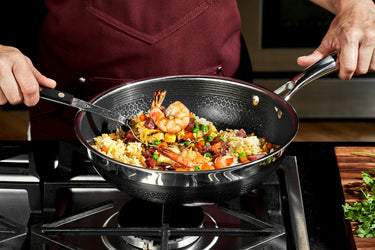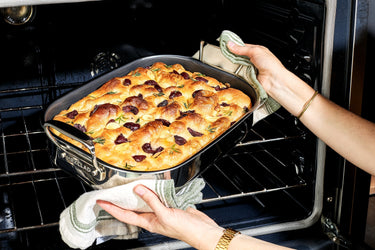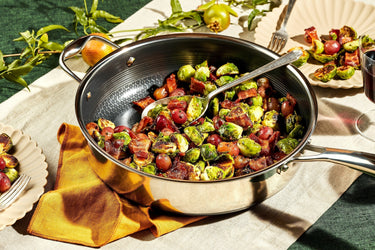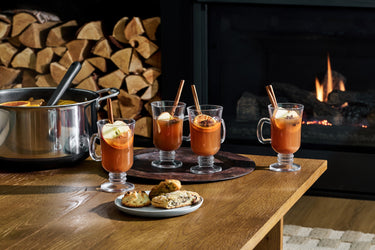What Is a Wok: Learn Why & How To Use Your Wok

If you’re in a time crunch but need to get dinner on the table, a wok is up to the task. This unique pot can help you cook filling and flavorful meals fast.
But what sets a wok apart from other pans, and how do you use one? While a wok’s less familiar shape may seem intimidating at first, you’ll never want to go without one again once you start using it.
Some dishes are uniquely suited to a wok, like stir fry. Plus, there are only a few tips to keep in mind when rocking with a wok. With this guide, you’ll be a wok-whiz in no time.
What Is a Wok?
A wok (which translates to “cooking pot” in Cantonese) is a versatile pan that was first created in China. Woks were probably invented during the Han dynasty — over 2,000 years ago — and are still a must-have for any budding or seasoned chef.
Traditional woks are round-bottomed pans with high walls. These dome-shaped woks are completely smooth, with high and slanted walls that are ideal for trapping heat and tossing ingredients. While less traditional, flat-bottomed woks are rising in popularity.
Round-Bottomed Woks vs. Flat-Bottomed Woks
Round-bottomed woks are commonly used in restaurants because they’re great for tossing ingredients and can withstand high heat on a gas stove.
When placed on a burner, the wok’s center retains most of the heat while the highest part of the curved walls holds the least. This allows chefs to control the temperature of their ingredients — which is especially helpful when making stir frys.
As oil pools in the center of the wok, ingredients can be tossed and moved to different parts of the pan depending on their desired temperature.
Flat-bottomed woks are ideal for home kitchens. Most kitchen stoves don’t get hot enough to provide the heat needed for the classic round-bottomed wok. Flat-bottomed woks are also compatible with electric stoves and induction stovetops, while round-bottomed woks are not.
Flat-bottomed woks can also hold more, which comes in handy when cooking for the whole family or hosting a dinner party. Because heat distribution is more even with a flat-bottomed wok, home cooks can heat ingredients more evenly — all without losing out on any of the benefits provided by the high, sloping walls.
The high, heat-trapping walls of the wok can speed up your cooking time compared to a regular frying pan without compromising on flavor. In fact, using a wok can add flavor to your dish.
What Are the Benefits of Using a Wok?
The wok’s high walls make this pot better suited for tossing than other pans. You can practice and perfect your tossing or speedy stirring skills when making a stir fry without losing food to the floor or stovetop. Wondering why? The high walls can help catch the ingredients back in the wok.
The walls also provide a heat gradient, so you can move ingredients around to keep them from becoming too hot or scorched.
A wok isn’t limited to serving up stir frys. With high heat retention, you’ll be searing meat like a pro. Unlike a frying pan or skillet, the high walls keep heat from evaporating as quickly, so you can get that desirable golden-brown sear in even less time.
The shape and depth of the wok also make it a great option for one-pot meals for the nights you need something low effort and easy to clean.
Enhanced Flavor With Wok Hei
Woks produce a smoky flavor that is sure to satisfy. This identifying flavor is a marker of the wok itself known as “wok hei” or “breath of the wok.”
Wok hei refers to the unique flavor that occurs when stir fry is made in a traditional wok. Wok hei has been credited to the process in which the wok heats up and allows for the Maillard reaction. That’s a complex chemical reaction in which protein reacts with reducing sugars via heat.
Basically, this process allows your food to caramelize and brown.
When food is tossed in a wok above the flame, the ingredients pass through the cloud of steam above the wok. Oil drips down into the flame, leading the flames to rise toward the ingredients. This not only causes the food to cook quicker, but also leads to a higher concentration of flavor.
Looks like science can be fun (and delicious).
When Should I Use a Wok?
While the wok has gained popularity for its killer stir-fry capabilities, there are no shortages of ways to use this handy pan.
Take advantage of the wok’s depth by cooking stews or boiling water to make all sorts of pasta dishes. You can fill the wok with oil to deep fry chicken, tofu… anything your heart desires! The concentration of heat on the bottom of the wok can provide enhanced frying and searing.
You can even use your wok to smoke meats and cheeses, fry eggs, or incorporate a lid to steam veggies and seafood.
How Do You Use a Wok?
Now that we know the benefits of using a wok, let's cover how to cook with one.
Choose the Right Oil
When it comes to your wok, you’ll want to use a cooking oil with a high smoke point (one that reaches about 400 degrees Fahrenheit before it starts smoking). Because the bottom of the wok can retain heat so well, using an oil with a low smoke point can lead to burnt oil. There’s no faster way to throw off the flavor of your dish.
To hit that sweet-spot smoking point, consider using one of the following oils:
- Peanut Oil – Peanut oil has a smoke point of 450 F and a nutty flavor that compliments many Chinese or Thai dishes.
- Avocado Oil – With a high smoke point of 500 F and mild flavor, avocado oil is an ideal choice when searing or frying foods in a wok.
- Vegetable Oil – This neutral oil has a smoke point of 400 F and can be paired with just about any ingredient.
- Soybean Oil – Another mild and neutral oil with a high smoke point of around 450 F, soybean oil is another great choice for stir frying.
- Grapeseed Oil – This mild oil can have a subtle fruity flavor and a smoke point of 400 F. Grapeseed oil is ideal for sauteing or frying a variety of foods.
Once you’ve decided on your oil of choice, let the wok heat up over medium-high heat. Then add about a tablespoon of oil, and lightly swirl the wok to help spread the oil all along the bottom and sides.
Add Your Ingredients Right
Adding your ingredients in the right order is key. We recommend cooking your protein first, then transitioning to your aromatics and veggies before adding the sauce.
Protein
Start with your protein, no matter what it is. You may want to pat your protein dry before adding to the wok, as this will help it sear rather than steam.
Once your oil is hot, place your protein in the bottom of the wok in a single layer. Let it sit for two to four minutes before turning so it can reach that desirable golden brown.
Once it’s starting to brown, flip it with a spatula, and repeat the process on the other side. Stir and salt your protein, then remove it from the wok shortly before it is fully cooked through (it will continue cooking when mixed back in with the other ingredients). Finally, set it aside.
Aromatics
Next, you’ll start cooking your aromatics. These are the herbs, spices, garlic, or onions you cook in oil to build the flavor profile for your dish. Cooking these early on will help release their flavors into the oil. When you add the other ingredients, the flavor base has already begun to build within the walls of the wok like magic.
Stir these ingredients consistently to help them merge with the oil. You may want to add another tablespoon of oil during this step, too.
A chuan or wide wok spatula is ideal for stirring and scooping, as it can fit into the angles of a wok better than a regular spatula can.
After about a minute of stirring, your aromatics should have started softening and releasing their aromas. At this point, you’re ready to add your veggies.
Veggies
For your vegetables, the cook time will vary depending on which specific veggies you’re using.
Harder veggies such as potatoes, Brussel sprouts, and broccoli need to cook for around six to seven minutes. Softer veggies like your leafy greens and tomatoes only need a minute or two to cook through.
If you’re using a variety of vegetables, throw the harder veggies into the wok first, and add in those with the shortest cook time last.
As your veggies cook, stir them often. If you’re feeling adventurous, try tossing during this step as well.
Combine and Toss
Once all of your vegetables are looking tender and close to done, add your protein back in. This is also when you can stir in your cooked rice or noodles if you’re using them.
If your recipe calls for sauce, pour it down the sides of the wok rather than dumping it directly over the ingredients. This will help heat the sauce before it comes into contact with the rest of your ingredients, keeping it from cooling anything down.
Finally, toss it all together. Once your protein is fully cooked and the sauce is thoroughly mixed in, it’s ready to serve. Let the compliments wok n’ roll on in!
What Material Should I Choose for My Wok?
When it comes to woks, there are a few different materials available.
Stainless Steel Woks
Stainless steel is a popular choice for its durability and chef-approved appearance. Stainless steel is less porous than other materials such as carbon steel or cast iron, which means you don’t need to season it as much for it to get the job done right.
However, stainless steel is not non-stick, which can make it a little trickier to work with.
Cast Iron Woks
Cast iron woks are super durable and a master at retaining heat. Cast iron can last forever, and using your cast iron also helps season it by creating a layer of non-stick hardened oil after each use that only gets better with age.
The downside is that cast iron woks are heavy, making them difficult to lift and toss.
HexClad Hybrid: The Best of Both Worlds
At HexClad, we design our woks using patented hybrid technology to bring you the best of both stainless steel and cast iron.
Our unique hexagonal design creates a series of peaks and valleys on our cookware. The peaks are made of stainless steel that can create a perfect golden-brown sear, while the valleys provide a nonstick surface.
At either 12 or 14 inches, our flat-bottomed woks can easily hold enough to feed the fam, without being too large, bulky, or heavy to move around and toss with ease. The two side handles are also ideal for shaking and tossing the wok while cooking.
Rock Out With Your Wok Out
Here at HexClad, we believe cooking should be enjoyable and accessible. That is why our woks are oven-safe for ease of use and dishwasher safe to keep clean up simple.
No matter how busy your night is or what ingredients you have in your fridge that need to be used up, a wok can help you create an egg-celently flavorful, satisfying, and quick meal that is sure to impress.
Source
Maillard Reaction - an overview | ScienceDirect Topics
Cooking with Fats and Oils: Can they withstand the heat? | Kendall Reagan Nutrition Center





